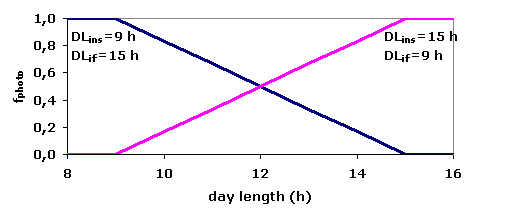Crop development is based on the thermal time accumulated between a base temperature (Tb, ºC) and a maximum (Tc, ºC), optionally modulated by a photoperiod factor.
Thermal time
Base and cutoff temperatures can be different for the periods sowing-emergence and emergence-harvest. Photoperiod-based correction can be activated for the period emergence-flowering. The degree-days are converted into a decimal code (assuming values from 0.00 to 4.00) to standardize development stages (phenophases are not explicitly determined).
Decimal codes are obtained with the following equations:
- Sowing-emergence

- Emergence-flowering

- Flowering-physiological maturity

- Physiological maturity-harvest

where DVS is development stage code, GDDcum (°C-days) are cumulated growing degree days, GDDem (°C-days) are growing degree days from sowing to emergence, GDDflo (°C-days) are growing degree days from emergence to flowering, GDDmat (°C-days) are growing degree days from flowering to physiological maturity, and GDDharv (°C-days) are growing degree days from physiological maturity to "harvestable". According to the implemented decimal code, 0.00 corresponds to sowing, 1.00 to emergence, 2.00 to flowering, 3.00 to physiological maturity, and 4.00 to harvestable. Listed below are decimal codes for the main stages:
Photoperiod
The response to photo-period is approximated by a linear relation of day length (DL, h), which fluctuates from 0 and 1, multiplicative of growing degree days accumulated in the course of crop development.
For long-day varieties:

For short-day varieties:

where DLins (h) is day length for insensitivity, DLif (h) is day length to inhibit flowering. The photo-periodic factor fluctuates between 0 and 1 within the two critical day-length thresholds.
The shape of fphoto is given in the exemplary graph below for both short-day (blue line) and long-day (fuchsia line) varieties:

Created with the Personal Edition of HelpNDoc: Easily create CHM Help documents